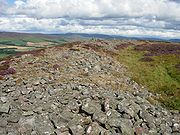
Caterthun
Encyclopedia

Caterthun, or the Caterthuns, is a ridge of hills near the city of Brechin
Brechin
Brechin is a former royal burgh in Angus, Scotland. Traditionally Brechin is often described as a city because of its cathedral and its status as the seat of a pre-Reformation Roman Catholic diocese , but that status has not been officially recognised in the modern era...
in Angus
Angus
Angus is one of the 32 local government council areas of Scotland, a registration county and a lieutenancy area. The council area borders Aberdeenshire, Perth and Kinross and Dundee City...
, Scotland
Scotland
Scotland is a country that is part of the United Kingdom. Occupying the northern third of the island of Great Britain, it shares a border with England to the south and is bounded by the North Sea to the east, the Atlantic Ocean to the north and west, and the North Channel and Irish Sea to the...
. The Caterthuns are notable for being the site of two Iron Age
Iron Age
The Iron Age is the archaeological period generally occurring after the Bronze Age, marked by the prevalent use of iron. The early period of the age is characterized by the widespread use of iron or steel. The adoption of such material coincided with other changes in society, including differing...
forts known as the White Caterthun and the Brown Caterthun.
The White Caterthun, on the west, is dominated by an oval fort consisting of a massive dry-stone wall, with a well or cistern in the middle. The light-coloured stone wall gives the White Caterthun its name. The photo shows part of the dry-stone wall on the summit of the White Caterthun:
The Brown Caterthun, on the east, consists of a series of earthen embankments (hence the name 'brown'). There is little evidence of settlement, agriculture or water supply here, so the purpose of the earthworks is uncertain. Brown may be from the British word for hill (bron / bryn).
Both Caterthuns show several entrances to the summit that radiate outwards, like the spokes on a wheel. The significance of these entrances, if any, is unknown, but they may have aligned with geographical features that no longer exist, such as other settlements. From radio-carbon dating, the Brown Caterthun appears to have been built and modified over several centuries in the latter half of the first millennium BC. Parts of the White Caterthun may have been contemporary with the Brown Caterthun, but it is believed that the main stone wall was built by the Picts
Picts
The Picts were a group of Late Iron Age and Early Mediaeval people living in what is now eastern and northern Scotland. There is an association with the distribution of brochs, place names beginning 'Pit-', for instance Pitlochry, and Pictish stones. They are recorded from before the Roman conquest...
or their progenitors in the first few centuries AD.

